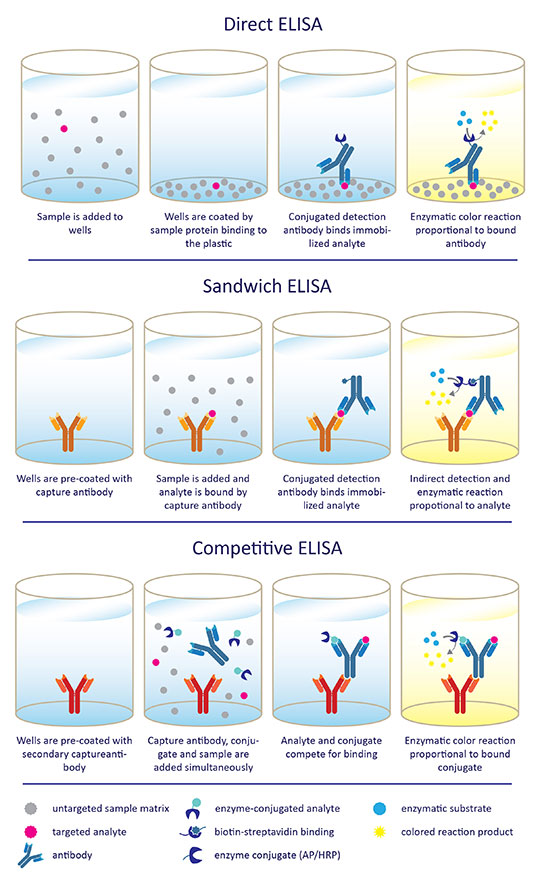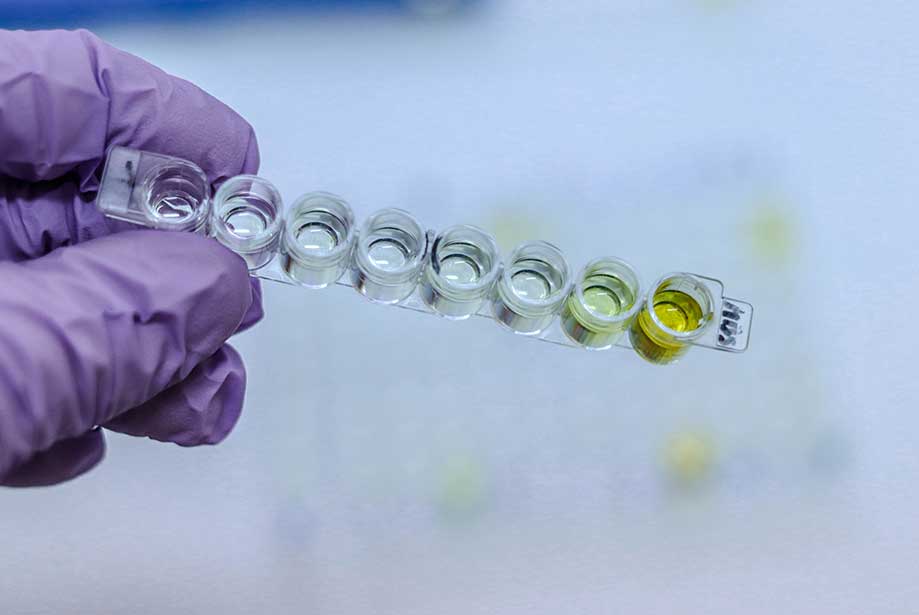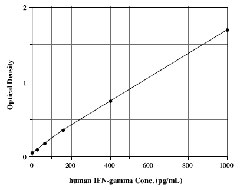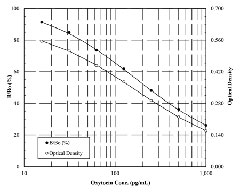The ABCs of ELISA Assays
Reliable enzyme-linked immunosorbent assays (ELISAs) for quantification of target substances crucially depend on carefully selected controls – they are the ABCs of ELISAs: it’s all
About
Binding
Controls.
To understand the types of controls and which of them to apply, it is important to understand the different types of ELISAs first (see our Tech Note “
What are the differences between ELISA assay types?” for a more in-depth review). Direct ELISAs have different needs for controls than sandwich or competitive ELISAs, and different means of sample preparation or detection require different controls as well.
There are three major types of ELISA principles. In direct ELISAs, the sample is coated onto the plate and the antigen in the sample, also known as the analyte, is detected by antibodies. Sandwich and competitive ELISAs both have plates that are coated with antibodies. In a sandwich ELISA, the plate is coated with capture antibody which binds the analyte and a second conjugated detection antibody binds the analyte and modulates the detection reaction. A competitive ELISA utilizes a conjugate, an analyte antigen coupled to a detection reagent, which competes with the analyte for binding. The more analyte is contained in the sample, the less conjugate will be bound and the lower the enzyme-mediated signal will be.

Figure 1. Types of ELISA.
|
Despite their different nature and nomenclature in dependence of the type of ELISA being used, controls can be classified into two groups: negative and positive controls.
Negative Controls are characterized by the absence of reagents or components that are necessary for successful analyte detection. Negative controls generally aim to estimate the level of nonspecific binding as well as to identify its source. The following negative controls are commonly used in ELISA:
Wavelength Correction is a common in-device correction of the signal that can be used independently of the type of ELISA being used. For wavelength correction, the substrate’s optic density (O.D.) signal is read at its specific wavelength and corrected against unspecific absorption at an off-wavelength outside the substrate’s spectrum. This allows to correct for changes in background absorption, which can be caused by the plasticware, condensation or contaminants as they might occur for example in whole cell ELISA.
Blank Controls are the most common negative control type, but possibly the most inconsistently used terminology. There is some ambiguity as to what exactly is a blank control. Blank empty wells that do not contain or have not seen any liquid at any point are one common form of blank controls, but probably just as common are assay buffer blanks, i.e. wells filled only with the ELISA’s buffer. Blanks are meant to analyze the contribution of background absorbance of the plastic and/or buffer to the signal. They are often omitted in favor of wavelength correction and/or S0 or NSB controls (see below). Some form of blank or background control should be run alongside standards and samples in every assay run, regardless of the ELISA being well established.
Another form of blank that is particularly useful in troubleshooting of unexpected background signal is often referred to as a
chromogen blank. Here, only substrate and stop solution are being added to a well. This control aims to check the substrate’s contribution to background, e.g. due to too old substrate.
S0 is a negative control that contains zero standard (or any other form of analyte, e.g. sample), but all other components for a successful color reaction are being added. In direct and sandwich ELISAs, this will lead to minimal color development determining the maximal background in the absence of analyte. The slight background often observed is due to unspecific binding of the detection antibody and can be utilized to control for sources of high unspecific background and means to eliminate it (e.g. wash steps, antibody dilutions etc.). The obtained S0 value can be used for value correction of all other obtained values (commonly known as “blanking”), but is more commonly used to determine the null value of the standard curve.
Non-Specific Binding (NSB) Controls in competitive ELISAs fulfill the same function as S0 in sandwich ELISAs – to determine the background occurring due to unspecific binding of the conjugated enzyme. As in competitive ELISAs, the enzyme is conjugated to analyte instead of to the detection antibody, unspecific binding needs to be analyzed in the absence of capture antibody and sample or standard analyte. The obtained non-specific background is often used to calculate NSB-corrected values for all other controls, samples and standards. It can furthermore be a useful tool determine the source of arbitrary high signals. To test unspecific background caused by the capture antibody itself, a sequential incubation of capture antibody with high concentration of standard analyte, followed by subsequent incubation with conjugate, instead of competitive incubation of standard and conjugate, can be a helpful mean to identify issues with the capture antibody.
Secondary/Detection Antibody Control are controls used mostly in direct and sandwich ELISAs. Their purpose is to test nonspecific binding of secondary or detection antibody in the absence of primary or capture antibody, respectively. While these controls can be generally omitted in routine ELISA runs, they might be able to provide valuable insight when troubleshooting sources of high background or the state of decay of assay components.
Negative Matrix Control is a means to determine the signal originating from analyte-independent matrix effects. A sample’s matrix is the entirety of all components contained in the sample, with the exception of the analyte. Especially complex matrices, such as blood samples, can contain a wide variety of components that might interfere with an assay’s signal in one way or another. Nonspecific binding to matrix components can lead to false positive signals, as well as false-negative signals. False-positive signals can be controlled for by measuring a negative matrix control, i.e. a sample matrix that is guaranteed to not contain any analyte. However, while being a useful control, it is often very difficult to impossible to obtain sample matrices that are guaranteed to be analyte-free.
Positive Controls aim to test the functionality of the assay as well as its feasibility to be used with the type of sample and sample matrix. The following positive controls are commonly used in ELISA:
B0 is a specific denomination of zero standard controls in competitive ELISAs. While technically the same as S0, i.e. the absence of any standard or sample analyte, it will – in contrast to S0 in sandwich ELISAs – lead to maximum color development, as the conjugated analyte does not face binding competition and maximal conjugate binding will be achieved. B0 is therefore in contrast to S0 a positive control useful to determine the maximum color development in competitive ELISAs and to control for full functionality of all assay components. It will generally result in values above the maximum detection range of an assay. B0 values can be used to reference the relative binding in a sample or standard to the maximum possible binding and even used to analyze assay readout. This ratio is commonly referred to as percentage of binding, %B, or B/B0. It is therefore recommended to include B0 controls into every assay run of competitive ELISAs, even if the assay and sample/matrix combination is well established.
Total Activity (TA) Controls serve to ensure enzymatic activity of the enzyme-conjugated antibody, biotin or analyte. They are also a useful tool to analyze the decay of enzymatic activity with long assay incubation procedures. To test enzymatic activity, only substrate and enzyme conjugate are incubated together during the assay’s development time and color reaction is stopped with stop buffer. TA is generally a purely qualitative control.
Standards are not commonly conceived as a positive control, but known quantities of analyte added to assay buffer is probably the purest form of a positive control. Not only are standards a useful tool to ensure an assay’s functionality, they are an indispensable part of any fully quantitative ELISA. A series of different known concentrations of analyte, most frequently obtained by serial dilution, are used to generate the assay’s standard curve. An accurate standard curve is an essential component of each assay run to determine the quantity of analyte contained in the unknown samples. While a standard is generally supplied with the assay for commercially available assay kits, it can pose quite some challenge to source suitable analyte standards for custom-made ELISAs.
Figure 2. Standard curves of a Sandwich (left) and Competitive ELISA (right).
are only used during development of ELISAs for protein targets. If recombinant proteins are being used as standards, it might be necessary to confirm that binding and detection of endogenous protein by the antibody components of the assay follows the same dynamics as recombinant proteins. For this purpose known quantities of endogenous protein are being employed as a positive control.
Positive Matrix Controls are samples of the same matrix as the unknown samples which are known to contain analyte, ideally in known quantities. These type of controls can serve both as a general positive control for the assay, as well as a control for matrix interference. In contrast to negative matrix controls, positive controls of known quantities can control for both false-negative and false-positive matrix interference.
Spiked Matrix Samples are often a preferred alternative over native positive matrix controls. Here, a sample preferably containing little to no analyte, is being supplied with known quantities of analyte in a process called “spiking”. Spiked matrix samples are not only very useful as positive controls with their ability to correlate measured values to expected values, they serve several additional purposes in ELISA validation. If matrix samples are being extracted prior to ELISA analysis, meaning that the sample is purified to enrich the analyte and/or eliminate interfering matrix contents, spiked matrix samples are a well suited mean to analyze the efficiency of extraction. As the input quantity of analyte before extraction is known, the recovered and detected quantities of analyte after extraction and ELISA analysis allow to assess the efficiency of the extraction protocol and optimize it. Ideally, extraction protocols are close to 100% efficiency, but at times it might not be possible to achieve this efficiency. In these cases, spiked matrix samples allow to approximate the original analyte content of unknown samples as well. Additionally, spiked matrix samples might be useful in linearity of dilution analysis.
Serial Matrix Sample Dilutions provide a valuable tool to analyze matrix interference and determine a dilution factor at which matrix interference is negligible. For this purpose a chosen sample in its matrix is serially diluted and measured by ELISA analysis. Obtained values in a linear relation to the dilution factor demonstrate the absence of matrix interference. Assays should only be run with matrix sample dilutions known to fall into a predetermined range with proven linearity of dilution, and linearity of dilutions needs to be validated for every combination of ELISA assay, sample matrix and analyte individually as a part of routine assay validation and optimization procedures. Serial matrix sample dilutions can be generated from spiked matrix samples, but it generally recommended to use a variety of samples to be tested, pool and mix these into one pooled sample and generate serial dilutions from this pooled sample. This method will average matrix interference over a broader variety of samples.
Validation and Controls
Regardless of which ELISA assay type, sample or analyte is being used, thorough validation during set-up and vigorous control of every assay run form the foundation of reliable quantitative ELISA results. For more information on the process of quality control and validation, please consult our technotes on
how to QC your ELISA results,
validation of sample dilutions and achieving linearity,
variation in ELISA and how to reduce it,
lot-to-lot reliability and our
10 tips for successful ELISAs. Enzo Life Sciences offers an extensive range of
ready-to-use ELISA kits for a variety of research fields. Our kits are highly published and well renowned and Enzo Life Sciences has decades of experience developing and optimizing commercial immunoassays to meet the ever-changing needs of our scientific community. We provide a broad range of immunoassay kits and other research supplies for
wildlife endocrinology,
immunology,
cancer,
neuroscience and other research fields, as well as industrial applications such as
bioprocess monitoring. For more information on assay validation please
download our ELISA E-book or contact our
Technical Support Team for further assistance.












